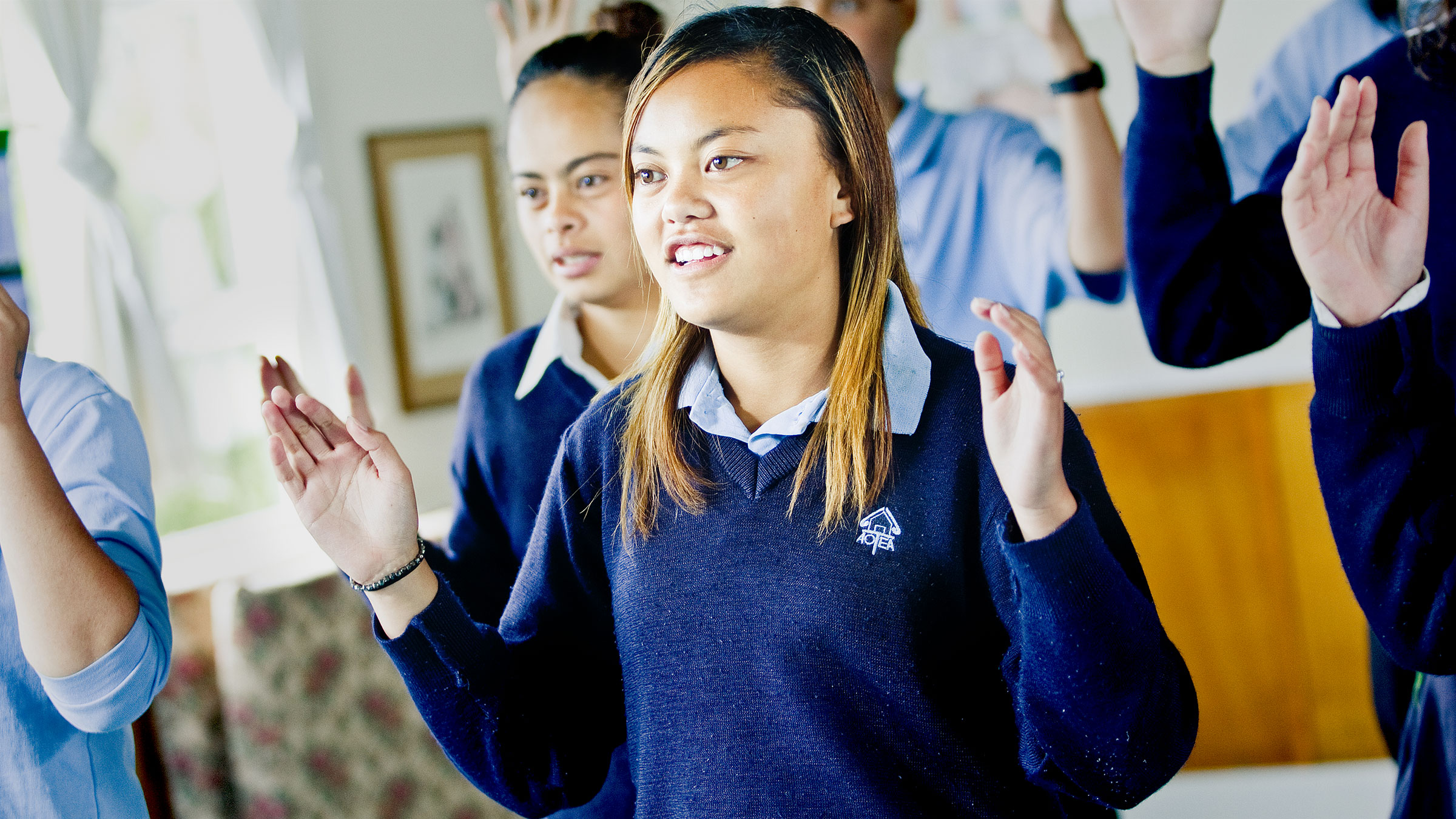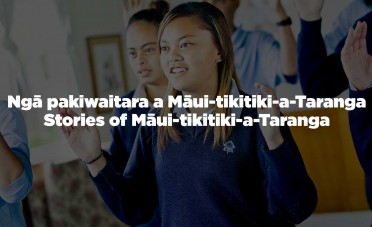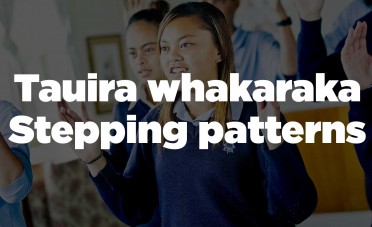Te hanga raupapa Creating movement sequences
Te hanga raupapa (create movement sequences) in response to a variety of dramatic themes.
Exploring te ao kori — Activity collections
This resource is part of a series within the Exploring te ao kori activity collections called Te kori me te puoro | Music and movement.

Intended outcomes
Ākonga:
- select, combine, and use elements of dance and use choreography to develop ideas about te ao kori
- research Māori pūrākau, and customary and contemporary Māori art, and show understanding of these through dance and movement performance
- present their dances about te ao kori within their school community and record their responses to their own and others' dances
- research the representations of Tāne Mahuta and read about Tāne Mahuta as the guardian of trees and birds and of all things in the forest to inform ideas for dance
- demonstrate a willingness to learn skills and extend their abilities by accepting the challenge of creating a movement sequence
- describe and demonstrate a range of assertive communication skills and processes that enable them to work in a group to develop a group movement sequence.
Suggested approach
Ngā paki o te tau me te huarere | Seasons and weather
In groups of four to six, each group is given a card that contains the following four words:
- Āwhina – helping, assisting, befriending, providing moral support
- Manaakitanga – hospitality and generosity
- Rangimārie – tolerance, being at peace with oneself and the environment
- Tikanga – customs and practices
In their group, ākonga discuss their understanding of these words and use them to develop a set of guidelines that will enable them to work cooperatively together. Groups report back to the whole class to help develop a set of class guidelines for cooperative activities.
Ākonga listen to one or more of the waiata (songs) from Te Wāo Nui a Tāne by Hirini Melbourne to study the following elements:
- te kōpere – the rainbow
- tīhore – to clear away
- ko te hau ora – the wind of life
- uira – lightning
- ngā whetū – the stars.
Using translations of te reo, groups of four to six ākonga discuss the ideas in the waiata and make a list of at least five different descriptive action words associated with weather and seasons, for example:
- hīhiko (flashing)
- ngunguru (rumbling)
- whakamataku (frightening)
- wiriwiri (shuddering)
- tūpoupou (plunging).
The groups explore shapes and movements associated with their words, for example, fast, sharp, long, diagonal movements, on and off the ground to represent flashing.
Each group develops a dance sequence that combines the movements inspired by their list of words. In developing their sequence, ākonga consider the class guidelines they have developed for working cooperatively. The groups perform their sequence for the class.
Watching ākonga are asked to provide feedback to the performing group, describing positive factors in the performance as well as suggesting possible changes to improve clarity, expression, focus, and visual or rhythmic interest.
All ākonga reflect and identify the aspects of working cooperatively that they did well and which aspects could be improved. The groups will then utilise this knowledge along with the feedback and practice their movement sequence again to enhance its presentation a second time. Video this performance for self/group evaluation and assessment.
Ngā manu whakamōrea | Endangered birds
Ākonga identify endangered native birds of Aotearoa and brainstorm issues that affect these birds, for example, predators (such as, stoats, weasels, feral cats), the behaviour of humans, the changes in the landscape, and the actions of institutions like the Department of Conservation and other groups to save endangered species.
Ākonga research the topic with knowledge sources, such as the Department of Conservation (under Conservation/Plants and animals/Native Animals and Threatened Species Trust Programme).
They write the script and create dances to present to friends, whānau, and their school community.
Ākonga plan a dance-drama that is to be used to inform others about the plight of our endangered birds.
Example:
- Scene 1: A narrator starts "Once upon a time, when the birds lived completely free of predators..." Ākonga depict through dance movement the variety of birds in the ngāhere (forest).
- Scene 2: The coming of the Māori and the capturing of birds for food.
- Scene 3: The coming of the Pākehā and the introduction of more predators.
- Scene 4: The destruction of the ngāhere, the birds' habitat.
- Scene 5: The shrinking of the native bird population.
- Scene 6: The realisation of the damage caused to the flora and fauna and the beginning of conservation and preservation.
See Ngā pakiwaitara a Māui-tikitiki-a-taranga, the Stories of Māui-tikitiki-a-taranga, and Waiata-ā-ringa, action songs, for ideas to develop movements that are inspired by the images and events in those songs or stories.
Ngā pūrākau me ngā pakiwaitara | Stories and myths
Some possible activities:
- In small groups, ākonga devise a movement/dance sequence, a chant, and/or a percussion composition to communicate the story of Ranginui and Papatūānuku.
- Ākonga write their own version of a customary story in te reo Māori or English and perform the story as a chant, haka, or waiata-ā-ringa (action song).
- Ākonga research Hineraukatauri, the goddess of music and dance. The case moth is her flute and the hanging fern her ringlets. They listen to or learn Hirini Melbourne's song 'Te Putorino a Raukatauri' ('Raukatauri's Flute') from Te Wao Nui a Tāne (Melbourne, 2000). Discuss the images in the song and those of the goddess of music and dance and experiment with how these might translate into movement.
- Ākonga listen to 'Hineraukatauri' from Oceania (Mohi, 1999), which Hinewehi Mohi wrote to honour her daughter. Compare the words, the images, and the music to Hirini Melbourne's song.
- Ākonga listen to 'Raukatauri' played on the pūtōrino (flute) by Richard Nunns from Te Ku Te Whe (Melbourne and Nunns, 1994). They research customary Māori musical instruments, for example, pūtorino, ihu, pūrerehua, kōauau, poiāwhiowhio (Melbourne, 1993).
- Ākonga create a movement/dance sequence about the creatures of Tāne to be accompanied by customary Māori musical instruments.
- Ākonga listen to and learn 'Koekoe', a song about the morning star and the dawn chorus of Tāne's birds (see Hei Waiata, Hei Whakakoakoa). Ākonga create an action song or a creative dance to accompany the song.
- Ākonga listen to and learn 'A Te Tarakihi' (The Cicada), a song based upon the words of an ancient chant (see Into Music 3). Ākonga discuss movement ideas based upon the flight of the cicada, including spatial pathways and body shape ideas. In small groups, ākonga create their own dance 'Flight of the Cicada'.
Ask ākonga to reflect upon the development and performance of movement/dance sequences based on any or all of the above.
Ākonga can consider how they felt about their own dance in terms of their personal movement preferences, their contribution to the development of the dance/movement performances, how they felt about performing beforehand, and their feelings after having performed. Ākonga can also record their responses to others' dances and share these in groups.
See Ngā pakiwaitara a Māui-tikitiki-a-tāranga, stories of Māui-tikitiki-a-Taranga, and Waiata-ā-ringa, action songs, for ideas to develop movements that are inspired by the images and events in these songs or stories.

